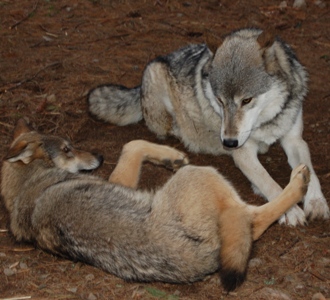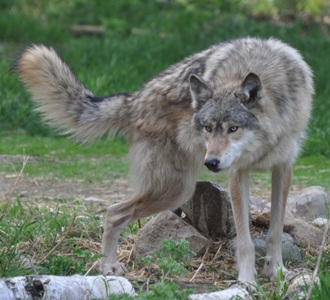Communication is an important part of the wolf social hierarchy. This unit will look at one aspect of communication, intraspecific or within the species. What comes to mind when you think about a wolf? Chances are, you may say howling. This is one of the most well-know forms of communication within the species, but is not the most common for wolves. The communication of body language is most well-known to wolves (and dogs...)
Communication
Many of us think of communication only as talking or writing to each other. Those are two ways humans share information every day. How do wolves "converse?" Even though they cannot talk or write, wolves communicate effectively in several ways.
Wolves use body language to convey the rules of the pack. A wolf pack often described as having an organized rank order, but it's more likely a reflection on the pack structure being parents and offspring. They are known as the dominant pair and are usually the only members of the pack to produce pups.

Any wolf can become dominant. However, to do so, it must find an unoccupied territory and a member of the opposite sex with which to mate. Or, more rarely, it moves into a pack with a missing dominant wolf and takes its place, or perhaps kills another dominant and pair bonds with its mate.
To communicate dominance, the wolves carry their tails high and stand tall. Less dominant wolves exhibit submissive behavior by holding their tails down and often lower their bodies while pawing at the higher ranking wolves.This drawing shows some features of the wolf that aid in communication.
There are two levels of submissive behavior: active and passive. Active submission is a contact activity in which signs of inferiority are evident such as crouching, muzzle licking and tail tucking. The behaviors typical of active submission are first used by pups to elicit regurgitation in adults. These behaviors are retained into adulthood by subordinate wolves, where they function as a gesture of intimacy and the acceptance of the differentiation of the roles of the wolves that are involved.
Passive submission is shown when a subordinate wolf lays on its side or back, thus exposing the vulnerable ventral side of its chest and abdomen to the more dominant wolf. The subordinate wolf may also abduct its rear leg to allow for anogenital inspection by the dominant wolf. If two wolves have a disagreement, they may show their teeth and growl at each other. Both wolves try to look as fierce as they can. Usually the less dominant wolf, the subordinate one, gives up before a fight begins. To show that it accepts the other wolf's authority, it rolls over on its back. Reactions to this behavior may range from tolerance (the dominant wolf standing over the submissive wolf) to mortal attack, particularly in the case of a trespassing alien wolf. Following the dominance rules usually keeps the wolves in a pack from fighting among themselves and hurting each other.

Wolves convey much with their bodies. If they are threatened, they may stick their ears straight up and bare their teeth. A wolf who is suspicious pulls its ears back and squints. Fear is often shown by flattening the ears against the head. A wolf who wants to play dances and bows playfully.
Until recently, scientists would use the term Alpha when describing a dominant wolf. Follow this link to discover why USGS biologist, Dave Mech is discontinuing the use of this concept of pack leaders fighting their way to the top. (http://www.davemech.org/news.html).
There are still still dominance issues, but not to the same degree that one might see in captive facilities. Also, dominance can be in the form of territorial behavior. Recent studies on Isle Royale in Lake Superior report a wolf killed in a territorial dispute. Their 2011 research report reads "In late February, the alpha male of Middle Pack was killed by the invading Chippewa Harbor Pack, reducing the population to 15 wolves. These events may result in a reduction to just one reproducing pack, for the first time in four decades." This wolf population is at a critical point with just one breeding female, take a moment to review the 2011 report, primarily the summary on pages 3 - 4.
http://www.isleroyalewolf.org/wolfhome/home.html
Wolves have a very good sense of smell about 100 times greater than humans. They use this sense for communication in a variety of ways. Wolves mark their territories with urine and scats, a behavior called scent-marking. When wolves from outside of the pack smell these scents, they know that an area is already occupied. It is likely that pack members can recognize the identity of a packmate by its urine, which is useful when entering a new territory or when packmembers become separated. Dominant animals may scent mark through urination every two minutes. When they do so they raise a leg, this dominant posture utilizes multiple forms of communication and is called a "Raised Leg Urination" or RLU.

Wolves will also use urine to scent mark food caches that have been exhausted. By marking an empty cache, the animal will not waste time digging for food that isn't there.
Wolves use their sense of smell to communicate through chemical messages. These chemical messages between members of the same species are known as "pheromones." Sources of pheromones in wolves include glands on the toes, tail, eyes, anus, genitalia and skin. For example, a male is able to identify a female in estrus by compounds (pheromones) present in her urine and copulation will only be attempted during this time.
Of course, their sense of smell also tells them when food or enemies are near.
Have you ever heard a
Barking is used as a warning. A mother may bark to her pups because she senses danger, or a bark or bark-howl may be used to show aggression in defense of the pack or territory.
Whimpering may be used by a mother to indicate her willingness to nurse her young. It is also used to indicate "I give up" if they are in a submissive position and another wolf is dominating them.
Howling is the one form of communication used by wolves that is intended for long distance. A defensive howl is used to keep the pack together and strangers away, to stand their ground and protect young pups who cannot yet travel from danger, and protect kill sites. A
To investigate howls on a more scientific level, review the work done with sonograms by NOVA.
Can you think of ways that humans communicate without using words?
To summarize, wolves use three different languages:
- Sound - Howls, Barks, Whimpers and Growls.
- Special Scents - Scats, Urine and Pheromones.
- Body Language - Body Positions and Movements and Facial Expressions.